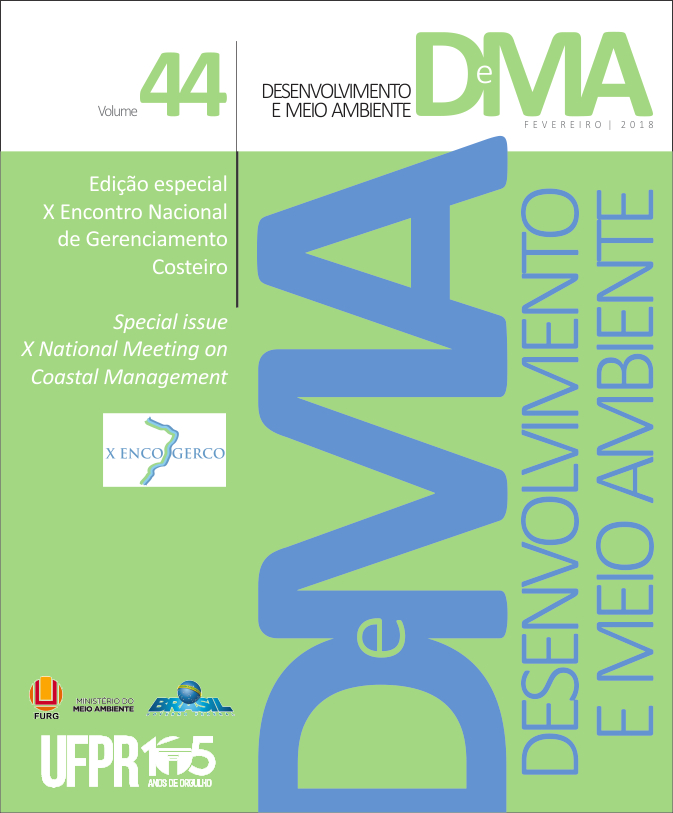Análise da adequação do Plano Estadual de Gerenciamento Costeiro de Santa Catarina aos temas relevantes para a gestão costeira integrada
DOI:
https://doi.org/10.5380/dma.v44i0.54967Palavras-chave:
indicadores de gestão, gestão adaptativa, gestão costeiraResumo
Iniciativas que visam à melhoria da gestão da zona costeira são abundantes, tanto no Brasil como internacionalmente. Neste contexto, o Plano Estadual de Gerenciamento Costeiro de Santa Catarina (PEGC/SC) configura um importante instrumento para a gestão costeira catarinense, uma vez que propõe programas, linhas de atuação e planos de ação que visam organizar os usos e as atividades verificados na zona costeira do Estado. Entretanto, mesmo com o PEGC/SC, nota-se que a decadência da qualidade ambiental e os conflitos de uso e ocupação na costa de Santa Catarina persistem, sendo problemas frequentes: perda de biodiversidade, redução da área de habitat crítico, fragmentação de ecossistemas, redução da diversidade de paisagens naturais, erosão da linha de costa, dificuldade de acesso aos bens de uso público, entre outros. Por conta disso, a análise do Plano Estadual de Gerenciamento Costeiro de Santa Catarina (PEGC/SC) aparece como etapa necessária para que seja possível identificar as fragilidades deste instrumento de gestão e apontar alternativas aos problemas verificados. Este trabalho analisou o PEGC/SC a partir da verificação do atendimento de suas linhas de atuação em relação a temas considerados relevantes no âmbito de gestão costeira. Conclui-se que o PEGC/SC atende a maior parte dos temas relevantes para a gestão costeira, apesar de apresentar fragilidades que poderiam ser minimizadas pela real implementação das propostas já existentes no PEGC/SC, juntamente com a adição de outras três linhas de atuação ao plano, sendo elas: Incentivo à declaração clara de política pública para a gestão costeira catarinense; Estabelecimento de programas de capacitação continuada para gestores e técnicos costeiros; e Incentivo à produção e à organização de conhecimento e informação de interesse para a gestão costeira.
Downloads
Publicado
Como Citar
Edição
Seção
Licença
Os Direitos Autorais sobre trabalhos publicados nesta revista são do autor, com direitos de primeira publicação para a revista. O conteúdo dos trabalhos publicados é de inteira responsabilidade dos autores. A DMA é um periódico de acesso aberto (open access), e adota a licença Creative Commons Atribuição 4.0 Não Adaptada (CC-BY), desde janeiro de 2023. Portanto, ao serem publicados por esta Revista, os artigos são de livre uso para compartilhar (copiar e redistribuir o material em qualquer suporte ou formato para qualquer fim, mesmo que comercial) e adaptar (remixar, transformar, e criar a partir do material para qualquer fim, mesmo que comercial). É preciso dar o crédito apropriado, prover um link para a licença e indicar se mudanças foram feitas.
Os conteúdos publicados pela DMA do v. 53 de 2020 ao v. 60 de 2022 são protegidos pela licença Creative Commons Atribuição – Não Comercial – Sem Derivações 4.0 Internacional.
A DMA é uma revista de acesso aberto desde a sua criação, entretanto, do v.1 de 2000 ao v. 52 de 2019, o periódico não adotava uma licença Creative Commons e, portanto, o tipo de licença não é indicado na página inicial dos artigos.




